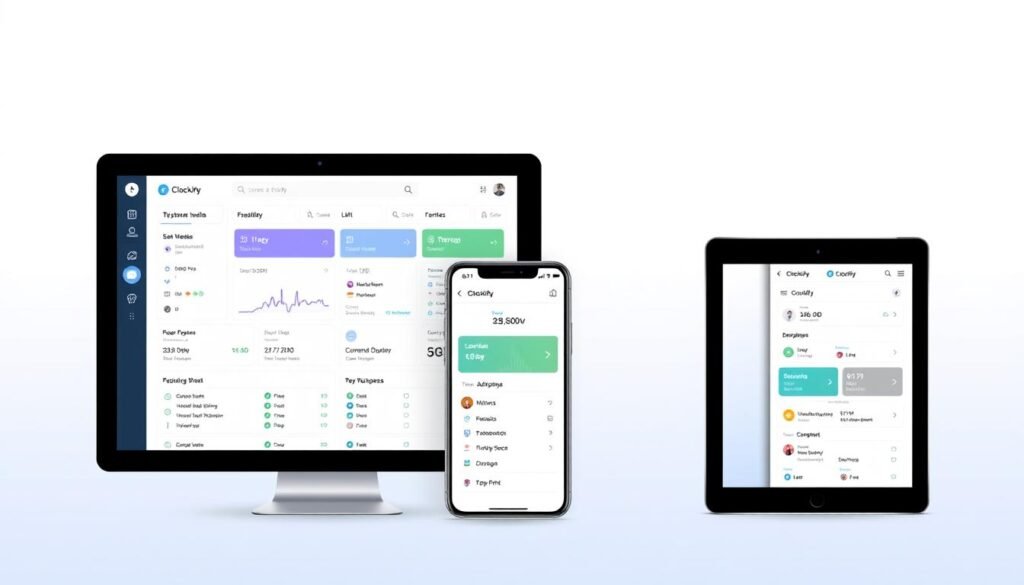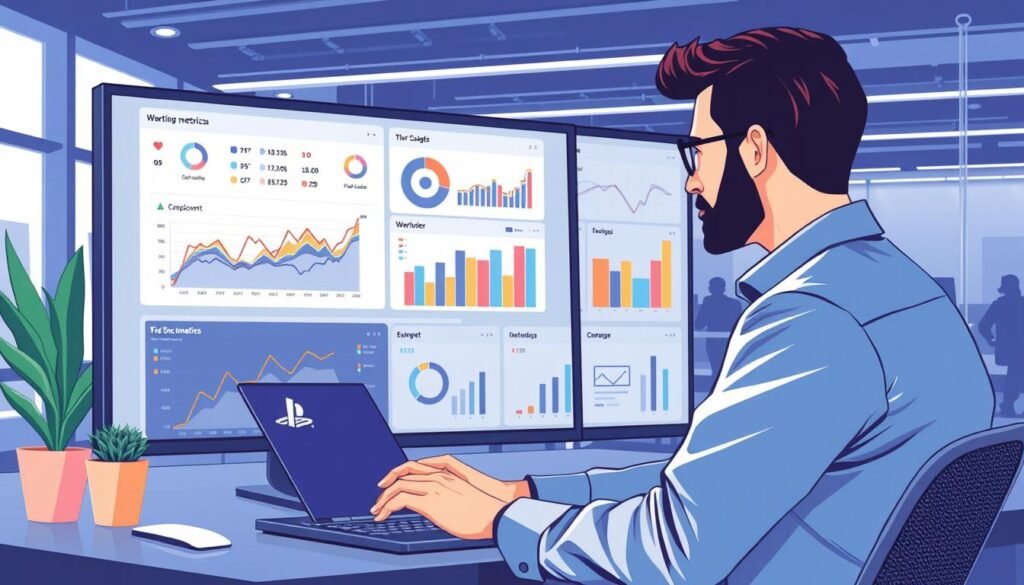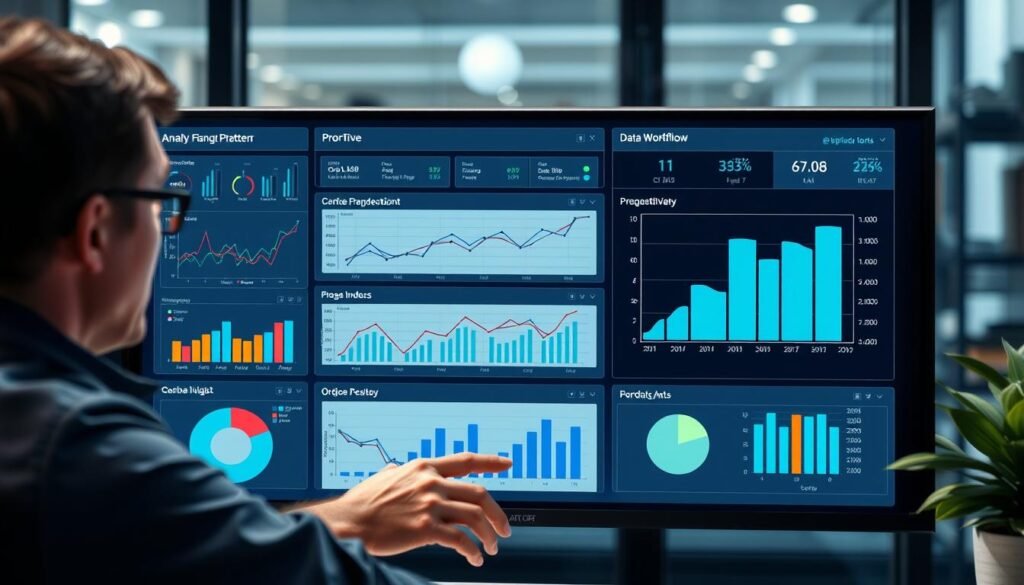In today’s fast-paced work environment, managing time effectively is crucial for businesses of all sizes. As we navigate the complexities of modern work, time tracking has become an essential practice for optimizing productivity.
We’ve seen a significant shift from traditional timesheets to sophisticated software solutions that offer valuable insights into productivity and project management capabilities. With numerous time tracking options available, selecting the right tool for your business needs can be daunting.
As we explore the world of time tracker tools, we’ll examine the key features to look for, compare top market offerings, and discuss how implementing the right solution can transform your workflow and boost your team’s efficiency.
Key Takeaways
- Understand the importance of time tracking in today’s work environment
- Learn about the various types of time tracking software available
- Discover key features to look for when selecting a time tracker tool
- Compare top time tracker tools on the market
- Understand how the right time tracking solution can boost team efficiency
Understanding Time Tracker Tools
In today’s fast-paced business environment, understanding time tracker tools is crucial for optimizing productivity and efficiency. As businesses strive to maximize their resources and improve their bottom line, the role of time tracking software becomes increasingly important.
What Are Time Tracker Tools?
Time tracker tools are specialized software applications designed to record and monitor the time spent on various tasks, projects, or activities by individuals or teams. These digital solutions have evolved significantly, offering features beyond simple time recording, such as project budgeting, automated invoicing, and productivity analysis. Time tracking software has become an indispensable asset for businesses, enabling them to gain valuable insights into their operations.
Why Time Tracking Matters for Businesses
For businesses, time tracking matters because it provides visibility into how resources are being allocated and identifies opportunities for improved efficiency. By using tracking software, businesses can establish accountability within teams and ensure accurate client billing, which is especially important for service-based businesses. The data collected through time tracking tools can inform strategic decisions about resource allocation, project pricing, and operational improvements.
| Benefits of Time Tracking | Description |
|---|---|
| Improved Productivity | Time tracking helps businesses identify areas where they can optimize their workflows and improve productivity. |
| Enhanced Accountability | By monitoring time spent on tasks, businesses can promote accountability within their teams. |
| Accurate Client Billing | Time tracking ensures that clients are billed accurately for the work completed. |
As we continue to navigate the complexities of modern business operations, the importance of time tracking and tracking software will only continue to grow. By understanding and leveraging these tools, businesses can position themselves for success in an increasingly competitive landscape.
Key Benefits of Using Time Tracker Tools
Time tracking is a crucial aspect of modern business management, and leveraging time tracker tools can lead to substantial productivity gains. By accurately tracking time, businesses can unlock numerous benefits that improve their overall efficiency and profitability.
Improved Productivity and Accountability
One of the primary advantages of time tracker tools is their ability to boost productivity. By monitoring how employees spend their work hours, businesses can identify areas where time is being wasted and implement strategies to optimize workflows. This increased awareness creates a culture of accountability, where team members take ownership of their tasks and deliverables, reducing procrastination and improving overall performance.
Accurate Client Billing and Invoicing
Time tracker tools enable businesses to generate accurate invoices based on the actual time spent on projects. This time tracking capability ensures that clients are billed correctly, eliminating disputes and enhancing client relationships. Automated invoicing also streamlines the billing process, improving cash flow and reducing administrative burdens.
Better Project Management and Resource Allocation
The data collected by time tracker tools provides valuable insights into project management, helping teams identify bottlenecks and optimize resource allocation. By understanding how much time is spent on different tasks and projects, managers can make informed decisions about resource distribution, ensuring that team members are utilized effectively and projects are completed efficiently.
To illustrate the impact of time tracker tools, consider the following comparison of businesses that have implemented time tracking:
| Business Metric | Before Time Tracking | After Time Tracking |
|---|---|---|
| Productivity | 60% | 85% |
| Client Satisfaction | 70% | 95% |
| Billing Accuracy | 80% | 99% |
As shown in the table, implementing time tracker tools can lead to significant improvements in productivity, client satisfaction, and billing accuracy. By leveraging these tools, businesses can make data-driven decisions to drive growth and success.

Essential Features to Look for in Time Tracker Tools
With numerous time tracking apps available, identifying the essential features is key to making an informed decision. When selecting a time tracking app, we need to consider several critical factors that can significantly impact its effectiveness.
Time Recording Capabilities
Flexible time recording capabilities are vital for accommodating different work styles. A good time tracking app should offer manual entry, automatic tracking, and idle time detection. This flexibility ensures that users can track their time accurately, regardless of their work environment or preferences.
Reporting and Analytics
The best time tracker tools provide comprehensive reporting and analytics features that transform raw time data into actionable insights. These features typically include customizable dashboards and exportable reports, enabling businesses to make data-driven decisions and optimize their operations.
![]()
Project Management Integration
Integration with project management platforms is crucial for a seamless workflow. By allowing time entries to be associated with specific projects, tasks, and clients without duplicate data entry, businesses can streamline their processes and reduce administrative burdens.
User-Friendly Interface
A user-friendly interface significantly impacts adoption rates among team members. Prioritizing software with intuitive navigation and a minimal learning curve is essential for ensuring that users can effectively utilize the time tracking app.
Other important considerations include mobile accessibility, timesheet approval workflows, and advanced features like screenshot capture and productivity scoring. Additionally, the ability to handle different billing rates, currencies, and tax requirements is vital for businesses working with international clients or contractors.
- Look for a time tracking app that offers flexible time recording capabilities.
- Ensure the app provides comprehensive reporting and analytics features.
- Prioritize integration with project management platforms.
- Choose software with a user-friendly interface.
Apploye: Best All-Around Time Tracker Tool
![]()
Apploye is a comprehensive time tracking platform designed to streamline employee time tracking, project management, and productivity monitoring. With its robust features and user-friendly interface, Apploye stands out as a versatile time tracker tool suitable for businesses of all sizes.
Key Features and Capabilities
Apploye offers a wide range of features that make it an ideal choice for businesses. Some of its key capabilities include:
- Project and task management with budgeting capabilities, allowing teams to track time against specific projects while monitoring costs and progress.
- Extensive reporting features that provide detailed insights into team performance, with exportable reports in PDF or CSV formats.
- Optional productivity tracking features, including screenshots, app tracking, website monitoring, and user activity tracking.
- Real-time monitoring through the Live Feed feature, enabling managers to see which employees are actively tracking time.
Pricing Structure
Apploye offers competitive pricing plans, with a Standard plan at $5/user per month and an Elite plan at $7/user per month. For annual payments, businesses can enjoy significant discounts, getting 6 months free, which translates to 50% savings on the yearly plan.
Pros and Cons
Apploye’s strengths include its comprehensive feature set, cross-platform compatibility, and seamless integration with payroll systems. However, businesses should also consider factors such as the learning curve for new users and the cost implications of scaling up their subscription.
Overall, Apploye is a powerful time tracker tool that enhances productivity and streamlines employee time tracking and project management processes, making it an excellent choice for businesses seeking to optimize their operations.
DeskTime: Best for Workflow Management
![]()
For companies seeking to optimize their workflow management, DeskTime offers a powerful time tracking app. Running silently in the background, DeskTime automatically tracks every hour worked, providing businesses with valuable insights into how their teams utilize their time.
Key Features and Capabilities
DeskTime excels in workflow management by automatically tracking time spent on various applications and websites, categorizing them as productive or unproductive based on customizable settings. Other notable features include:
- Break tracking and overtime monitoring to ensure compliance with labor laws.
- Document title tracking for granular insights into specific files and projects.
- A built-in Pomodoro timer to encourage healthy work habits.
- Cost calculation features to understand the financial implications of time spent on projects and clients.
Pricing Structure
DeskTime offers a flexible pricing structure to accommodate different business needs:
- Lite: Free plan for one user.
- Pro: $7 per user per month.
- Premium: $10 per user per month.
Pros and Cons
Users appreciate DeskTime’s ability to help maintain work-life balance through break reminders and productivity insights. However, some users note limitations in the reporting functionality, particularly for payroll purposes.
Overall, DeskTime is a robust time tracking software that excels in workflow management, making it an ideal choice for businesses seeking to optimize their operations.
Harvest: Ideal for Project and Expense Tracking
![]()
For businesses seeking a straightforward yet powerful tool for tracking time and expenses, Harvest stands out as an ideal solution. Harvest is commonly known as one of the simplest time tracking apps, providing valuable insights into projects and team performance.
Key Features and Capabilities
Harvest’s timesheet functionality includes start/stop timers, automatic reminders, and easy-to-use interfaces that encourage consistent time tracking across teams. The platform excels in project reporting, providing detailed insights into team performance, project budgets, and revenue tracking to help businesses understand profitability.
The invoicing capabilities allow businesses to automatically generate invoices based on tracked time and expenses, streamlining the billing process. With integrations like QuickBooks, Zapier, Slack, and Microsoft Outlook, Harvest is a versatile addition to existing workflows.
Pricing Structure
Harvest offers a free plan for 1 seat and 2 projects. The Pro plan is priced at $13.75 per seat, per project, and the Premium plan is $17.50 per seat, per project. This seat-based pricing structure may be less cost-effective for teams working on numerous projects simultaneously.
Pros and Cons
Users praise Harvest for its reliability and intuitive interface, making task-switching and logging hours for different clients effortless. However, some users note that the project setup process could be more streamlined, though the platform has consistently improved over time.
The key benefits of using Harvest include its ability to track work hours accurately, provide detailed project insights, and streamline invoice generation. While the seat-based pricing may not be ideal for all teams, Harvest remains a top choice for project management and expense tracking.
Time Doctor: Perfect for Hybrid Work Environments

For businesses navigating the complexities of hybrid teams, Time Doctor offers a comprehensive time tracking and productivity monitoring solution. This tool is specifically designed to support hybrid work environments, providing robust features for tracking employee time whether team members are working remotely or in the office.
Key Features and Capabilities
Time Doctor combines comprehensive time tracking with productivity measurement tools, including web and app tracking, screenshots, and distraction alerts to keep teams focused. Its timesheet functionality provides detailed records of work hours, with options for offline time tracking to accommodate various working conditions.
Pricing Structure
Time Doctor offers a tiered pricing structure to suit different business needs: Basic at $8/user/month, Standard at $14/user/month, and Premium at $20/user/month. This flexibility makes it an attractive option for businesses of various sizes.
Pros and Cons
Users appreciate Time Doctor’s mobile application, which enables time tracking while traveling or working away from their primary workstation. The platform also offers manual time editing options for situations where automatic tracking isn’t feasible. However, some users find the activity monitoring features occasionally intrusive, though these can be customized to balance productivity insights with employee autonomy.
In conclusion, Time Doctor is a versatile tracking software that supports hybrid teams by providing comprehensive time tracking and productivity monitoring features. Its adaptability and range of features make it an ideal choice for businesses looking to optimize their time tracking processes.
Best Free Time Tracker Tools
For businesses and freelancers on a tight budget, finding a free time tracking tool that doesn’t compromise on features is crucial. The good news is that several excellent options are available, offering robust functionality without the cost.
TimeCamp: Unlimited Users with Free Plan
TimeCamp stands out with its free plan that supports unlimited users, offering automatic time tracking and productivity monitoring, customizable billing rates, and invoicing capabilities. Its integration with popular tools like Airtable, Asana, and iCal makes it a versatile addition to existing workflows.
![]()
Clockify: Comprehensive Free Features
Clockify provides one of the most comprehensive free time tracking apps on the market. Its features include a start/stop timer, manual time entry, timesheet functionality, and detailed reporting. Users can access Clockify across all major platforms, ensuring consistent time tracking regardless of device preference.

Jibble: Free Forever for Unlimited Users
Jibble offers a “free forever” model for unlimited users, featuring facial recognition for secure clock-ins, GPS tracking for field workers, and detailed reporting and analytics. Its ease of use makes it ideal for organizations with frequent staff changes, as new team members can be onboarded with minimal training.
![]()
These best free time tracking solutions demonstrate that businesses don’t need to compromise on functionality when working with budget constraints. By leveraging these tools, businesses can enhance productivity, streamline operations, and make informed decisions based on accurate data.
Specialized Time Tracker Tools for Different Needs
The one-size-fits-all approach doesn’t work when it comes to time tracking for diverse business needs. Different businesses have unique requirements, and using a generic time tracking tool can lead to inefficiencies and inaccuracies.
Hubstaff: Best for Field Employee Management

Hubstaff excels in managing field employees with its robust GPS tracking capabilities, geofencing technology, and mobile-friendly interfaces. This makes it an ideal solution for construction, delivery, or service-based businesses with remote workers. The platform’s project budget and payroll features integrate seamlessly with location data to ensure accurate compensation for field employees while maintaining accountability.
Insightful: Focused on Employee Monitoring

Insightful focuses on comprehensive employee monitoring with features like apps and website tracking, stealth mode, and screenshots. This provides managers with detailed visibility into team activities. The platform works offline and syncs data when connectivity is restored, making it suitable for teams working in areas with unreliable internet access.
ActivTrak: Advanced Analytics and Insights

ActivTrak differentiates itself through advanced analytics that transform raw activity data into actionable insights about productivity patterns, workflow optimization, and team performance. The platform emphasizes transparency and trust, providing coaching tools that help managers support employee development rather than simply monitoring activity.
These specialized tracking apps demonstrate how time tracking technology has evolved to address the diverse needs of modern businesses across various operational models. By choosing the right tool, businesses can improve productivity, enhance accountability, and make data-driven decisions.
How to Choose the Right Time Tracker Tool for Your Business
Choosing the right time tracker tool is crucial for businesses aiming to optimize their productivity and streamline operations. The decision-making process involves several key considerations that can significantly impact the effectiveness of the chosen solution.
Assessing Your Business Requirements
Begin by assessing your business requirements, including whether you need basic time tracking or additional features like project management, invoicing, or employee time monitoring. Consider your primary goals for implementing time tracking software—whether it’s improving productivity, ensuring accurate client billing, or managing remote teams more effectively.
- Identify the core features that your business needs from a time tracking solution.
- Consider the scalability of the software as your business grows.
- Evaluate the integration capabilities with other tools and systems you currently use.
Considering Team Size and Structure
Team size and structure significantly impact your choice of time tracking software. Some solutions are optimized for freelancers or small teams, while others offer robust features for enterprise-level organizations. Consider your team’s work patterns, including whether employees work in-office, remotely, or in the field, as this will determine which track time features are most relevant.
- For smaller teams, ease of use and simplicity might be key factors.
- Larger teams may require more complex features and administrative controls.
- Consider the level of support and training required for your team.
Evaluating Budget Constraints
Budget constraints play a crucial role in decision-making when selecting a time tracking software. While free or low-cost options may be attractive, they may lack features that could ultimately save your business time and money. Evaluate the total cost of ownership, including implementation time, training requirements, and potential productivity gains, rather than focusing solely on subscription fees.
- Assess the total cost of ownership, not just the initial cost.
- Consider the potential return on investment (ROI) of the time tracking solution.
- Look for software that offers a free trial or demo to test its features before committing.
By carefully considering these factors, businesses can select a time tracking software that meets their specific needs, enhances productivity, and supports their growth objectives.
Implementing Time Tracking in Your Organization
To maximize the benefits of time tracking, careful planning and execution are crucial for successful implementation within your organization. Implementing a time tracker tool can significantly enhance time management and employee productivity. However, it requires a thoughtful approach to ensure employee buy-in and maximize adoption.
Best Practices for Rollout
A well-defined rollout strategy is essential for the successful implementation of time tracker tools. Begin with a pilot phase involving a small group before expanding to the entire organization. This allows for adjustments based on initial feedback. Clearly communicate the purpose and benefits of time tracking to employees, emphasizing how it supports better time management, fair workload distribution, and accurate client billing.
- Start with a small pilot group to test the system and gather feedback.
- Communicate the benefits of using a time tracker to employees.
- Provide comprehensive training to ensure employees understand how to use the timesheet software effectively.
Addressing Employee Concerns
Addressing employee concerns about privacy and surveillance proactively is crucial. Be transparent about what data will be collected, how it will be used, and who will have access to it. This transparency helps build trust and encourages employees to embrace the new system.
Some key considerations include:
| Concern | Action |
|---|---|
| Privacy and Surveillance | Be transparent about data collection and usage. |
| Complexity of the System | Provide comprehensive training and support. |
| Impact on Workload | Emphasize how time tracking can help manage workload more effectively. |
Training and Adoption Strategies
Developing comprehensive training materials is vital for the successful adoption of timesheet software. This includes videos, documentation, and live training sessions to accommodate different learning styles. Consider appointing “champions” within each department who can provide peer support and encouragement.
To further enhance adoption, establish clear policies around time tracking expectations, including when and how employees should track employee time, what constitutes billable versus non-billable work, and how to handle exceptions. Regularly solicit feedback about the time tracking process and be willing to make adjustments to improve user experience.
Conclusion: Making Time Tracking Work for You
As we navigate the complexities of modern business, effective time tracking emerges as a crucial element in driving success. The right time tracker tool can transform how your business operates, making it more efficient and productive.
Time tracking is not just about monitoring hours worked; it’s about gaining valuable insights that can inform business decisions. By leveraging tracking software, businesses can improve project estimation, client billing, and resource allocation.
The key to successful time tracking lies in striking a balance between accountability and trust. It’s essential to use tracking data to identify patterns and opportunities, rather than micromanaging individual activities. This approach empowers teams to work more efficiently and with greater awareness of how they allocate their time.
- Effective time tracking enables businesses to make data-driven decisions, driving growth and improvement.
- The right tracking software should adapt to your business processes, not the other way around, ensuring seamless integration with existing workflows.
- As remote and hybrid work models become increasingly prevalent, time tracking tools will continue to evolve, offering more sophisticated features for maintaining productivity and collaboration.
By adopting a time tracker tool that aligns with your business needs and embracing a culture of transparency and trust, you can unlock the full potential of time tracking. This enables your organization to optimize efficiency, drive success, and stay ahead in today’s competitive landscape.
FAQ
What is the best way to track employee work hours?
We recommend using a reliable time tracking software that allows employees to log their work hours accurately. This can be done through a desktop app, web app, or mobile app, depending on your business needs.
How do I choose the right time tracking app for my business?
When selecting a time tracking app, consider factors such as ease of use, features, pricing, and integration with your existing project management software. We suggest assessing your business requirements, team size, and budget constraints to make an informed decision.
Can I track employee productivity with time tracking software?
Yes, many time tracking software solutions, such as Time Doctor and ActivTrak, offer features that help you monitor employee productivity. These features can include automated time tracking, screenshots, and activity monitoring.
Are there any free time tracking tools available?
Yes, there are several free time tracking tools available, including Clockify, TimeCamp, and Jibble. These tools often offer limited features in their free plans but can be a good starting point for small businesses or teams.
How do I ensure accurate client billing with time tracking software?
To ensure accurate client billing, we recommend using a time tracking software that allows you to generate detailed reports and invoices based on tracked work hours. This can help you bill clients accurately and reduce errors.
Can I integrate time tracking software with my existing project management software?
Yes, many time tracking software solutions, such as Harvest and Toggl Track, offer integration with popular project management software. This can help streamline your workflow and improve productivity.
How do I address employee concerns about time tracking?
To address employee concerns, we suggest communicating the benefits of time tracking, such as improved productivity and accurate client billing. You can also involve employees in the selection process and provide training on how to use the time tracking software effectively.
